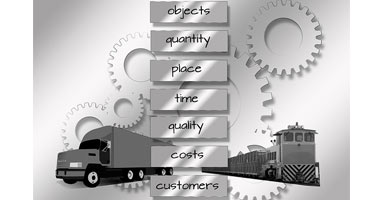Digitization to Fuel the Growth of India’s Logistic Sector

Coming to the business sector, logistics management holds a very prime status in operating a business.
Importance of Logistics Management in India
Before that let us know what is logistics management?
Logistics management deals with the co-ordination of resources or the flow of resources from the point of supply to the set destination in a meticulous way. The whole process involves huge volume of data that demands accurate approach and analysis. But on the same, it should not eat away the time, which can affect the timeliness of a respective sector. The assured quality and the guaranteed quantity is what your client expects from you.
To meet every growing demand the need to go real-time has become quite necessary. For instance, real-time tracking helps you in knowing the status of product delivery.
From point A (source) to point B (destination), numerous aspects are considered which are to be proper to mark a successful delivery. True, we can see few traces of digitization, but a complete transformation is what needed to see that efficient growth.
India, with a growing economy, definitely supports the above account decisively. Even with abundant resources, sometimes without proper logistics management, the scarcity can occur.
With global clients to serve, one should aim in providing effective service by switching from traditional logistics service to a digital one.
Benefits of Digitization/Digital Technology in the Logistics Sector
Right product, at the right place, in right time, and in right condition is what logistic management is all about. Let’s see how digitization is helpful in the whole process.
Automatic identification technology, communication technology, and information technology, on the basis of these, the logistic firms are advancing.
- Radio Frequency Identification (RFID)
- An Automatic Identification and Data Capture (AIDC) technology, RFID deals with radio waves that allow precisely storing and retrieving the data. Unlike barcode scanning, you can do the same wirelessly, which comparatively takes lesser time and effort.
- Resources can be easily tracked through individual identifiers and real-time updates. Inventory level management is easier under RFID.
- Electronic Data Interchange(EDI)
- The main concept of digitization is to go paperless/ support paperless transactions, well EDI will help you in that.
- Not only it is secure but also promises with a faster transaction process. Business documents, invoices, can be easily transferred without any setbacks.
- Enterprise Resource Planning(ERP)
- A business solution/software, ERP allows organizations to effectively address the issues of concern. Product distribution, staff maintenance, well, the supervisors will find it easy to perform any task without much effort.
- ERP marks the true impression of digitization as it primarily focuses on reducing the inventory costs and improving the turnover rate.
In this post, there is a discussion about only a few conveniences, but the digitization process provides a lot more than I have explained. With the right technology and suitable strategy, the growth optimization will always be there.



 +91 8277203000
+91 8277203000
